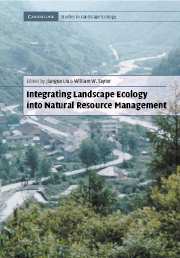Book contents
- Frontmatter
- Contents
- List of contributors
- Foreword
- Preface
- Acknowledgments
- PART I Introduction and concepts
- PART II Landscape structure and multi-scale management
- PART III Landscape function and cross-boundary management
- PART IV Landscape change and adaptive management
- PART V Landscape integrity and integrated management
- PART VI Syntheses and perspectives
- Index
- Plate Section
PART III - Landscape function and cross-boundary management
Published online by Cambridge University Press: 14 January 2010
- Frontmatter
- Contents
- List of contributors
- Foreword
- Preface
- Acknowledgments
- PART I Introduction and concepts
- PART II Landscape structure and multi-scale management
- PART III Landscape function and cross-boundary management
- PART IV Landscape change and adaptive management
- PART V Landscape integrity and integrated management
- PART VI Syntheses and perspectives
- Index
- Plate Section
Summary
As research and management expand from small scales to large scales, boundary- related issues become increasingly important, because large areas encompass various boundaries, such as natural boundaries (e.g., watershed boundaries and boundaries of a natural forest stand), ownership boundaries, political boundaries, and management boundaries. While research and management within a boundary are not easy, research and management across boundaries are even more challenging because a host of additional factors needs to be considered. First, landscape functions, such as flows of energy, matter, and organisms, cross a number of boundaries, as they may not recognize various boundaries. As a result, the effects of management activities within a boundary may extend to a larger area. Second, people (e.g., landowners, managers, and resource users) within different boundaries have different goals (e.g., social, economic, and ecological). Thus, solutions to management practices for multi-boundary landscapes depend not only on the management within individual boundaries but also on the coordination of management across boundaries as well as the integration of natural and social sciences. To address these topics, Part III includes three chapters concerned with boundaries between ownerships, between patches within a landscape, and between aquatic and terrestrial landscapes.
Spies et al. (Chapter 7) find that there are both significant opportunities and challenges in managing natural resources across multi-ownership landscapes, because of spatial interactions across ownership boundaries. Using the Oregon Coast Range Physiographic Province as a case study, the authors demonstrate how ownership patterns influence ecological patterns and processes, and how management activities by one owner can impact other owners.
Information
- Type
- Chapter
- Information
- Integrating Landscape Ecology into Natural Resource Management , pp. 177 - 178Publisher: Cambridge University PressPrint publication year: 2002
